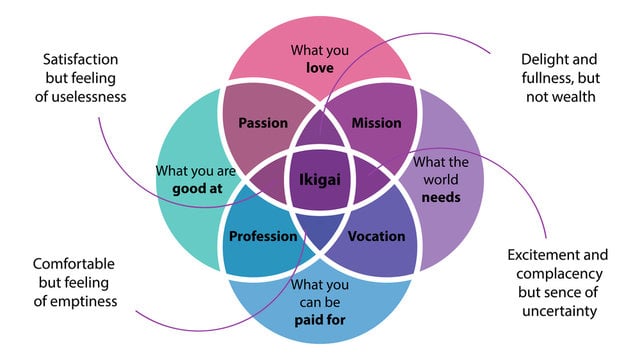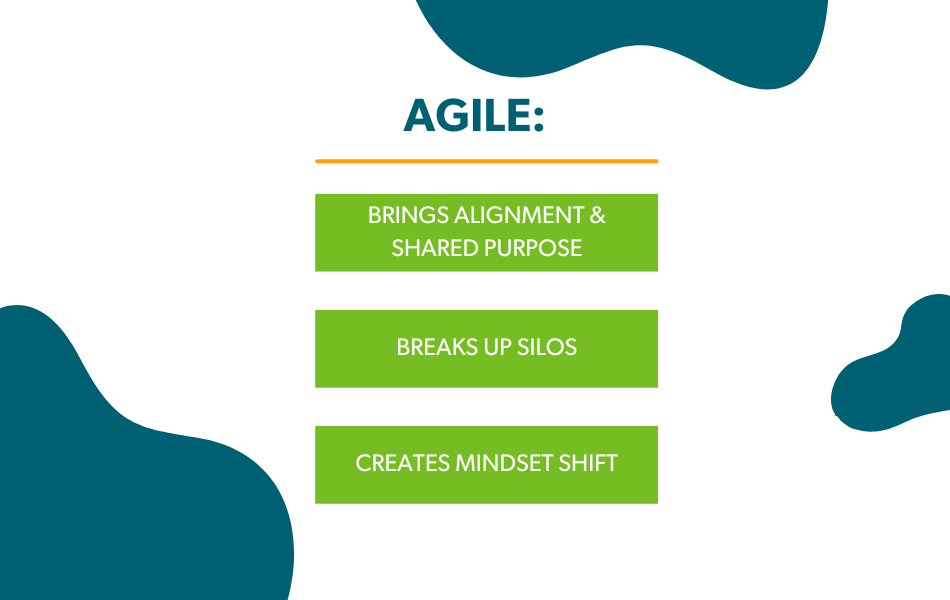Every marketer has encountered a situation where they have awareness of the importance of the work they do, yet aren't appreciated. This is about much more than how marketers feel. If team members believe their contributions don’t play a valuable role in terms of business goals, it can lead to burnout, high-employee turnover, and poor performance.
Fortunately, the Japanese have already figured out the formula for finding the right balance of purpose, happiness, and success that keep humans motivate: Ikigai. The concept allows people to find meaning in what they do. What’s even better is that Agile can actually help marketers like you find your Ikigai so you can be fulfilled in your professional life.
What is Ikigai?
Ikigai is a Japanese concept the literal translation of which is "a reason for being." The word combines the syllables “iki”, which means life, and “kai”, which translates to worth. Ikigai is the reason you wake up every morning. It’s your purpose.
Ikigai originated from the fundamental well-being and health concepts of traditional Japanese medicine. In particular, to denote the connection that exists between mental and physical well-being that is closely related to the sense of purpose in life.
A successful personal and professional life depends on making an impact and finding fulfillment. At their cores, the pillars of Agile and Ikigai concepts are very similar. Both promote passion, collaboration, and freedom on the path to feeling purposeful.
Understanding this concept is still just one step toward uncovering what your Ikigai truly is. So let's see how marketers can use Agile to find it for themselves.

The 4 Questions that Lead to Ikigai
Both Agile and Ikigai place an emphasis on process, immersion, mastery, and sharing this excellence with others rather than blindly following a single, unrealistic goal just because a manager or senior leader said so. Both also focus on work that is meaningful and impactful.
As you define your path forward in marketing, these are fundamental questions you should be asking in order to lean into your own personal Ikigai:
What Do You Love?
Your Ikigai should be something that you enjoy doing. Any activity that makes you feel good counts. There are no limits. It can be as simple as cooking, painting, dancing, etc.
The problem for marketers that already know what they love is that they can forget how much they love marketing when poor processes govern their way of work. Fortunately, marketers can push the reset button of what they love by adopting a new Agile approach.
Both Agile and Ikigai are complementary approaches to figuring out what within marketing you actually enjoy. That might be diving into analytics, creating content, or working closely with clients. As a result, marketing will feel impactful again.
What Are You Good At?
Finding out what you’re good at is an essential element for coming closer to discovering your Ikigai. This includes anything you're naturally good at or something that you’re an expert at and can do with ease. For example, content writing or design, or account management. Any activities or skills that you want to learn or are currently mastering should also be considered here.
By setting up an Agile environment where marketers are encouraged to be creative and innovative, team members have the space to figure out what they’re good at and develop those skills further. As marketers discover their Ikigai, they can more readily participate in a cross-functional team and develop their skills among a wider breadth of disciplines to become t-shaped individuals.
What Can You Get Paid or Rewarded For?
Your Ikigai should not only make you feel fulfilled, but also result in remuneration. Think about the skills others are willing to pay you for.
Enjoying what you do and being skilled at it is insufficient. It's important that you receive fair payment for your work, as this enables you to feel completely valued.
For example, you can feel worthy when your efforts lead to a positive impact on the business. Therefore, you can be fairly paid for the work you do because it’s valuable. Contrast this with some professionals who are paid well for work they don’t feel is really valuable, creating a dissonance.
What Does the World Need?
The final element of Ikigai is the feeling that you're doing something that the world needs. People feel their best when they contribute to a higher purpose and vision that make communities or the world a better place.
Nowadays, marketers can struggle to find fulfillment in their work since they frequently fail to see its significance. Knowing that your job has the potential to impact other people's lives will help you find your Ikigai.
For example, the main benefit Agile brings via Ikigai is the focus on providing stakeholder value. This ensures you’re creating something that someone actually needs. Ideally, the additional effectiveness Agile marketing brings can help you be more selective about jobs or clients, making it easier to work on projects you feel are worthwhile.
In practice, this often involves having access to organizational objectives, campaigns, and responsibilities. This means high-level strategy gets communicated across all areas of the organizational hierarchy to allow marketers to view the entire picture of how the business operates and develops thanks to their efforts. So individuals know what the people around them need and feel they can deliver it.
Agile Reminds Marketers Why They Chose This Field
Agile marketing so often gives marketers newfound enthusiasm. With the transparency the methodology delivers, marketing leaders may eliminate silos, increase team effectiveness, and rediscover the original reason they fell in love with the field.
Similar to the Ikigai concept, with an Agile marketing approach in place, people are empowered to experiment, learn, and not have to be afraid of failure. Rather than getting stuck on the hamster wheel of stagnation, they're given the freedom to prioritize and focus on their goals.

Agile Brings Alignment & Shared Purpose
One of the primary elements of Ikigai is the feeling of purpose and contribution. Agile offers a value-focused approach that helps marketers and adjacent functions feel their worth. When people's work is recognized and rewarded, they continue to contribute to the team. This fosters long-term motivation and commitment.
A key component of a successful Agile marketing organization is how you treat the individuals within it. People must understand that their role is important and what they do contributes actively to the higher business objectives for the year or quarter.
In fact, according to the 5th State of Agile Marketing Report, it’s clear how marketing contributes to the organization's long-term success for 72% of Agile marketers.
With the Agile approach, marketing teams feel more purpose in their work and have a stronger strategic base when they understand how their actions are advancing the overall business objectives.
Agile Breaks Up Silos
Silos are the source of many problems within organizations. Everyone works in a bubble that prevents them from collaborating and coming up with more creative solutions.
Departments lose sight of the bigger picture when silos are formed. They are unable to concentrate on reaching corporate objectives. As a result, there’s a loss of potential to provide high-quality and better-valued products.
The concept of Ikigai has a heavy emphasis on feeling and realizing your importance in your larger professional, and sometimes also personal, context.
Fortunately, Agile marketing is a great way to break down silos within this department. Using transparent, visual workflows, each team members in an Agile marketing team is able to view their individual assignments as parts of a team level workflow.
Instead of a cluster of teams focused only on their own chunk of the marketing scope, cross-functional team structures allow for greater exposure to different parts of the department and more opportunities collaboration. As a result, Agile team structures make it easy to see how your work today is connected to that of others in your department.
Mindset Shift
Whenever we talk about new approaches such as Ikigai or Agile, we have to remember that the mindset is the make-it-or-break-it factor in reaping their benefits. Without the right mindset, going to work becomes a hassle and can eventually become outright soul-crushing, especially when you don’t receive any kind of personal fulfillment from your position.
Agile isn’t just a way of working, it’s a way of thinking. That's why having like-minded team members and a supportive leader is essential for a successful Agile marketing implementation as well as discovering your Ikigai.
Next Step: Organizational Ikigai
In contrast to pushing growth at all costs, Ikigai offers businesses the chance to sit back, reflect, and reevaluate their fundamental purpose. Businesses are living, evolving organisms and their purposes may change as they grow. Keeping marketers as well as individuals across departments tapped into the purpose as it evolves is key to long-term success.
You'll find that as more and more marketers find their Ikigai through implementing Agile principles, other business functions will likely begin to follow suit.



